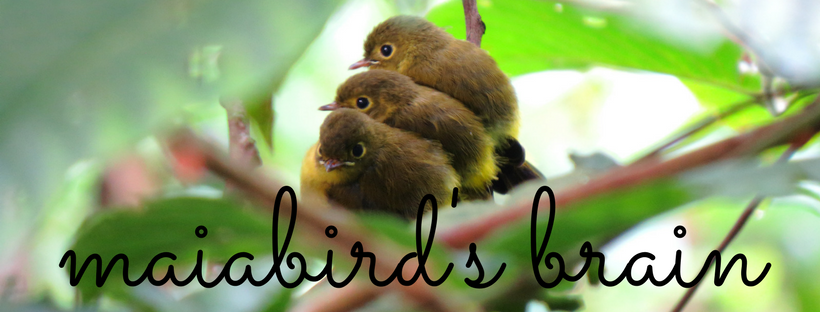Our friend Leni invited us to go birding with her in the La Mesa Ecopark on Tuesday. As we were discussing our plans, we decided to include a visit to the nesting Philippine Frogmouth that was recently spotted in the La Mesa Nature Reserve. Our new birder friend from Taiwan, Wayne (who participated in the 6th International Hornbill Conference) also wanted to see the Luzon subspecies of the Philippine Frogmouth. So the plan was set: La Mesa Nature Reserve first, then La Mesa Ecopark next.
Jops unfortunately couldn't escape from work that day, so he just brought me to Jollibee to meet up with Leni, Joni, and Wayne. And we were off!
Kuya Efren was once more our guide in the LMNR and we took a nice walk to the nest site. Along the way, we were treated to great views of a very green and plump Guaiabero. We also saw an active Collared Kingfisher nest visible from the trail and saw the adult bird fly out of the nest hole.
We soon reached the nest site and saw that the Frogmouth was sitting on a white ball of fluff! Upon closer inspection (of course through our binoculars and camera LCD screens) we confirmed that it was indeed a chick! The egg has hatched!
After spending a few minutes observing the birds, we exited the area and headed back up to the parking lot. We spoke to Kuya Efren and Sir Jo about being more careful now that the egg has hatched. We said our goodbyes and headed to the La Mesa Ecopark.
It was mid-morning and getting a bit hot already. Thankfully, the trails were shaded by the trees and it was nice and cool to bird in. We bumped into new WBCP member Anthony who was photographing birds in the trails and chatted for a while. We walked deeper into the trails and soon found one of Leni's most wanted birds for that morning: a Slaty-legged Crake.
When the bird disappeared from view, we back-tracked to find the next bird on her list: Hooded Pitta. Joni almost immediately spotted one, sitting very still on the ground. It was my first time to photograph this bird and I was very happy that it stayed very still =)
 |
| The Philippine Frogmouth sitting on a white ball of fluff |
 |
| A closer look at the newly hatched chick |
 |
| The young bird moved a bit and here you can partially see the yellow eye ring of the chick. |
After spending a few minutes observing the birds, we exited the area and headed back up to the parking lot. We spoke to Kuya Efren and Sir Jo about being more careful now that the egg has hatched. We said our goodbyes and headed to the La Mesa Ecopark.
It was mid-morning and getting a bit hot already. Thankfully, the trails were shaded by the trees and it was nice and cool to bird in. We bumped into new WBCP member Anthony who was photographing birds in the trails and chatted for a while. We walked deeper into the trails and soon found one of Leni's most wanted birds for that morning: a Slaty-legged Crake.
When the bird disappeared from view, we back-tracked to find the next bird on her list: Hooded Pitta. Joni almost immediately spotted one, sitting very still on the ground. It was my first time to photograph this bird and I was very happy that it stayed very still =)
It was approaching noontime and even in the heat, lots of birds were calling and flying about: Grey-backed Tailorbirds, Black-naped Orioles, and Philippine Pygmy Woodpeckers. It was also nest-building season for Lowland White-eyes and I was able to count at least four nests being constructed.
We dipped on the Red-bellied Pittas though which were nowhere to be seen that morning. On the way out of the trail, we saw an Ashy Ground Thrush singing loudly very close to the trail and another Slaty-legged Crake foraging on the ground.
We already had a very birdy morning but we ended it with a quick visit to the Philippine Scops Owls in Quezon City after a delicious lunch. We were able to see two juveniles and one adult.
 |
| Adult and juvenile owl sitting side by side |
 |
| The second juvenile owl stared at us with its huge, round eyes! |
We left after a few minutes, said goodbye, and went our separate ways. Quezon City did not disappoint us birders with so many wonderful birds we saw that Tuesday morning =)



























